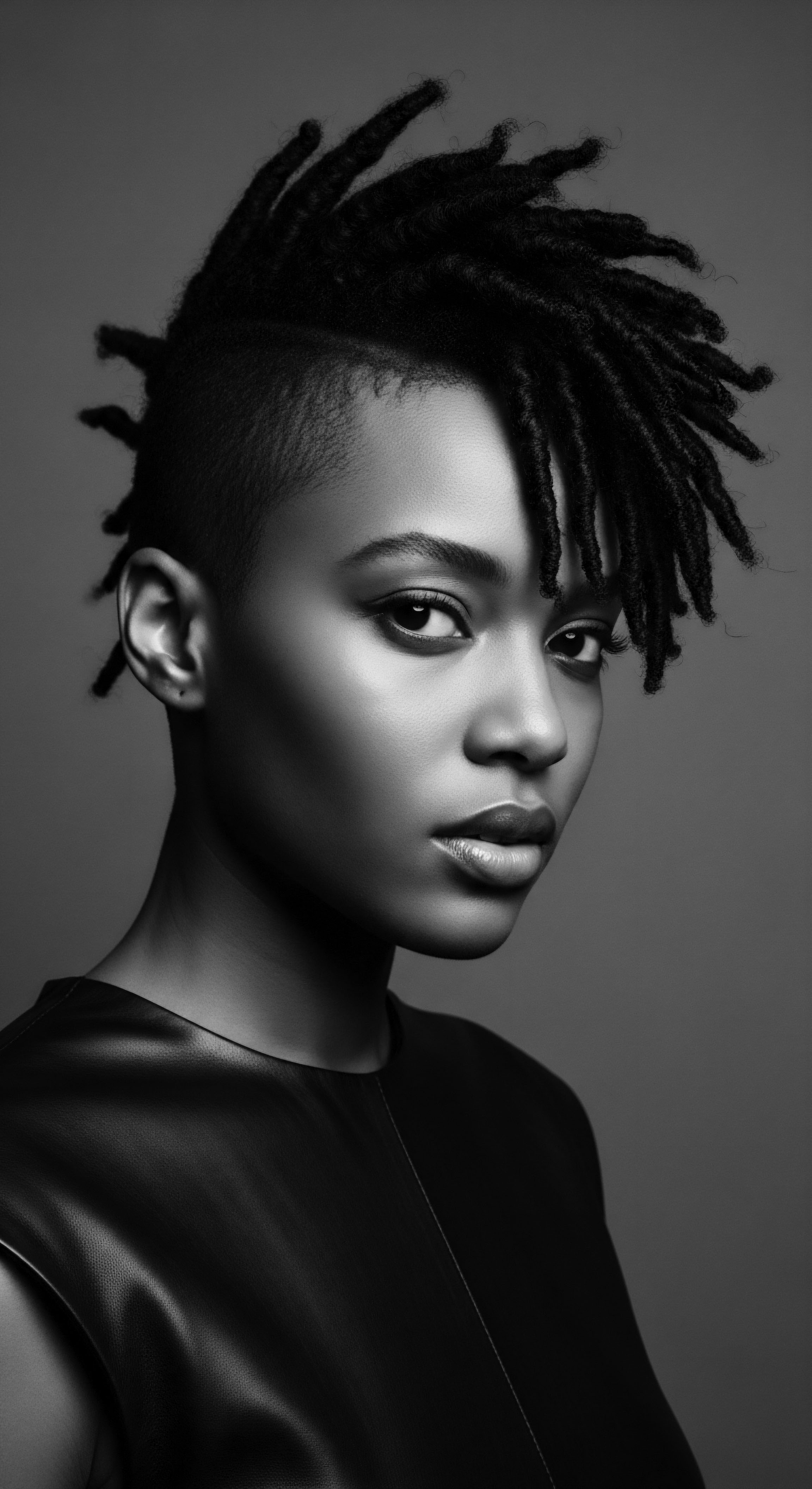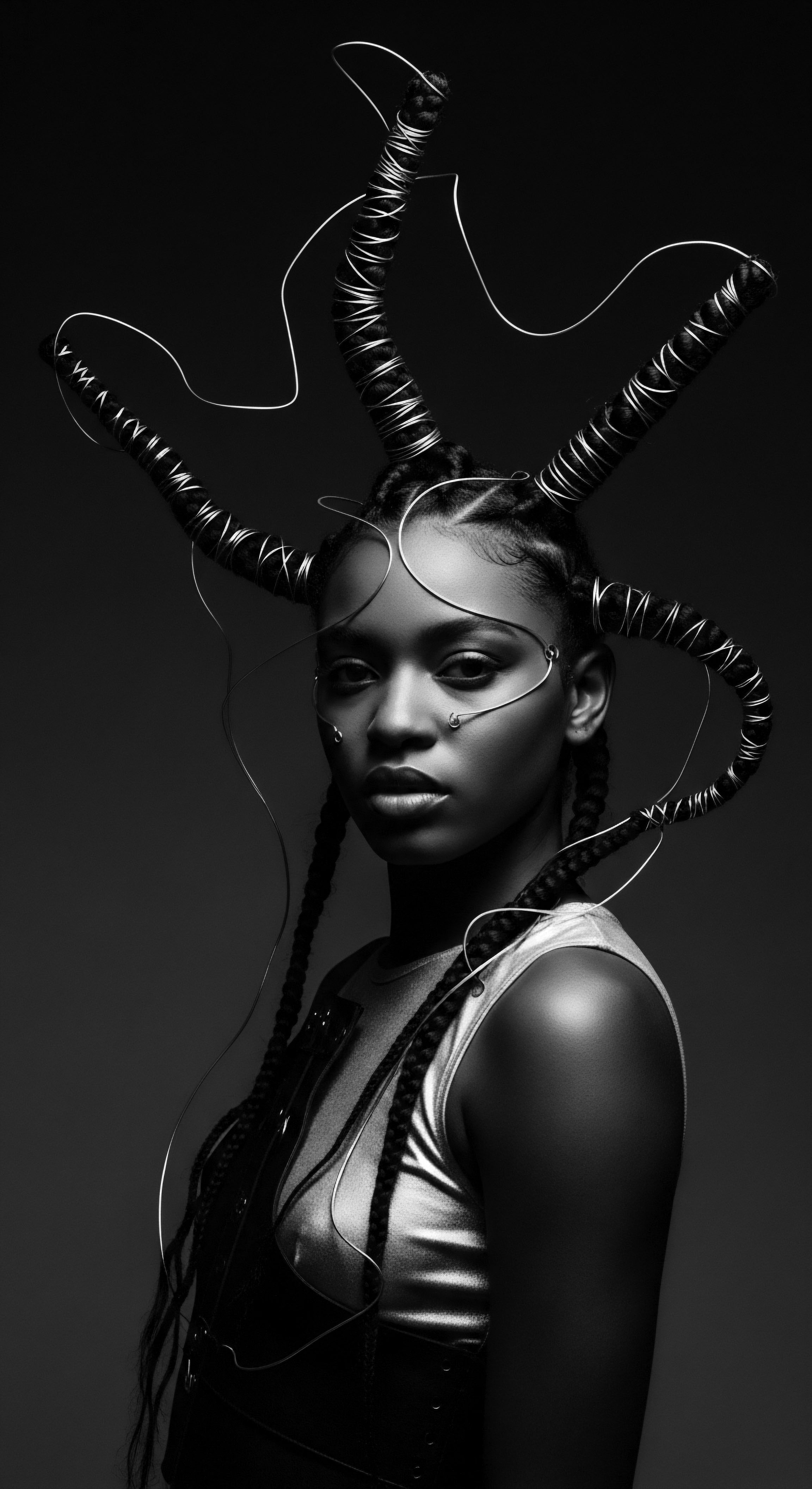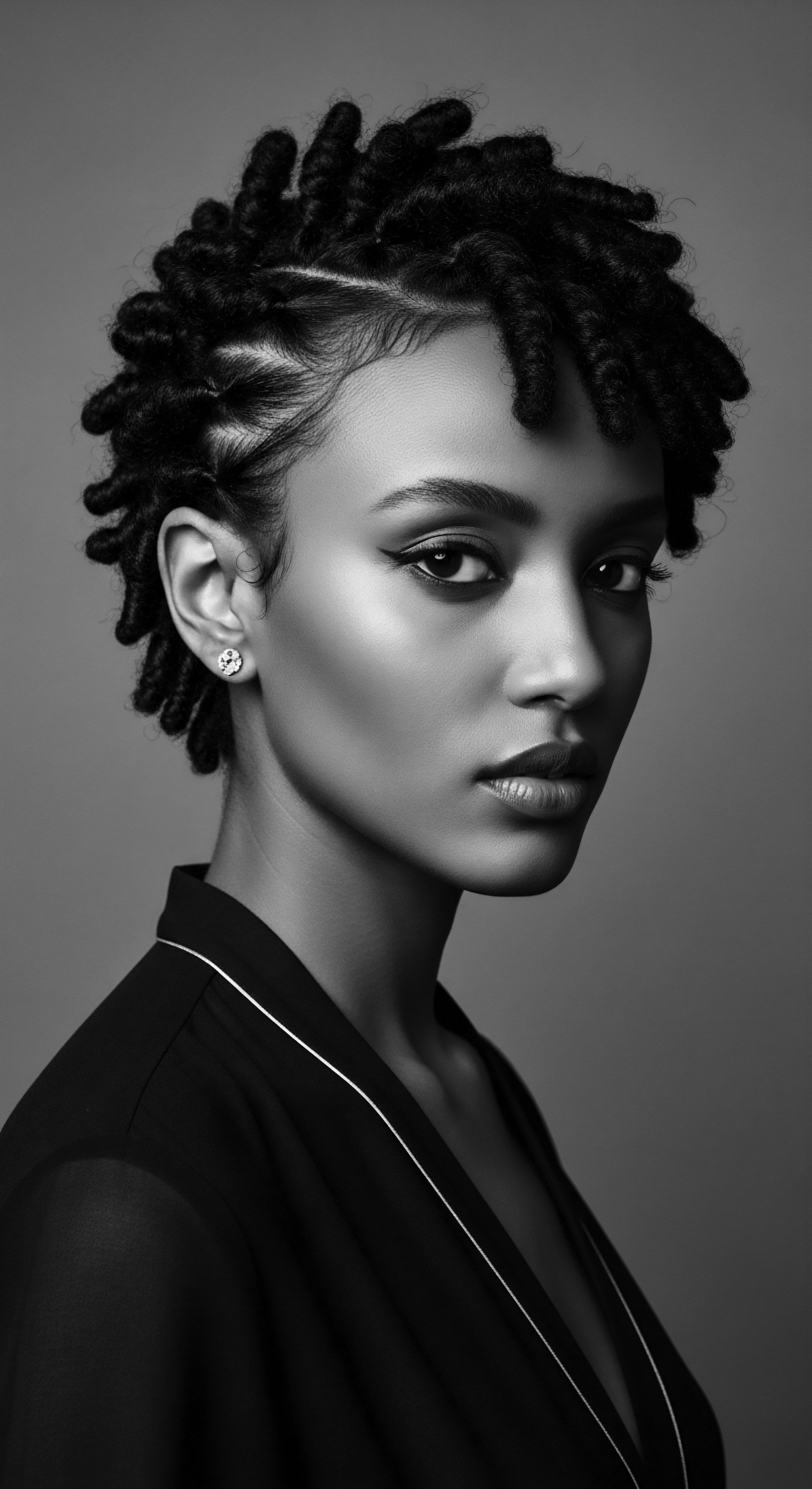
Roots
Consider, if you will, the intimate exchange between our strands and the very earth that cradles our lineage. For those among us whose hair coils and twists, whose textures speak of ancient winds and resilient suns, there dwells an undeniable ancestral call, a whisper of wisdom held within each curl. This exploration asks us to turn our gaze backward, not to dwell in a stagnant past, but to seek the enduring guidance offered by generations past. Can ancient oiling rituals, practices steeped in tradition and intuition, truly illuminate the path for our modern textured hair care?
The answer, I believe, lies within a collective memory, a deep understanding of what our hair has always asked of us, and how our ancestors provided. It is a story told not in fleeting trends, but in the enduring legacy etched into the very fiber of our beings.

The Intrinsic Structure of Textured Hair
The physical makeup of textured hair presents a distinct set of characteristics, distinguishing it fundamentally from straight hair types. Its elliptical cross-section, coupled with the unique helical growth pattern of the follicle, creates a strand that possesses inherent bends and twists. These structural distinctions mean that sebum, the natural oil produced by the scalp, struggles to descend the length of the hair shaft.
Consequently, textured hair often experiences a natural dryness, making external lubrication not merely a luxury but a fundamental requirement for maintaining vitality. This inherent dryness, a biological truth, forms the cornerstone of why oiling rituals found their genesis in communities across the globe, particularly where textured hair was predominant.
Our hair’s anatomy, a testament to its protective capabilities in diverse climates, reveals a fascinating interplay of keratin protein and disulphide bonds, shaping its characteristic spring and curl. Understanding this elemental biology is a step towards honoring its needs, much as our forebears did. They recognized, without the aid of microscopes, the thirst of these strands and sought to quench it with the bounty of their lands.
Textured hair’s unique structure inherently limits natural oil distribution, establishing a long-standing necessity for external lubrication practices.

Ancestral Lexicon and Hair Classification
Before the advent of modern classification systems, ancestral communities developed their own rich lexicons to describe and categorize hair, often tied to social status, tribal identity, and spiritual meaning. These descriptions, passed down through oral traditions, reflected a profound observation of hair’s many manifestations. While contemporary systems like the Andre Walker typing chart attempt to numerically categorize curl patterns, they often lack the historical depth and cultural specificity that our ancestors applied. Their understanding was less about a number and more about the hair’s behavior, its response to moisture, and its capacity for adornment.
Consider, for example, the various terms used within different West African societies to describe hair textures, which often correlate directly with traditional care practices. A hair type that readily accepted rich, heavy oils for definition and protection might be named differently from one that preferred lighter applications. These distinctions, while not formalized in scientific papers until recently, represent a sophisticated, lived knowledge of textured hair and its particular requirements, forming a vital part of its heritage.

Traditional Hair Growth Influences
Beyond anatomical specifics, hair growth cycles and overall scalp health were historically influenced by a myriad of environmental and nutritional factors. Diets rich in indigenous fruits, vegetables, and lean proteins, coupled with lifestyles attuned to natural rhythms, supported vibrant hair. The practices of oiling, scalp massage, and gentle handling were not isolated acts but integral components of a holistic approach to wellbeing, directly impacting the hair’s ability to flourish. This historical perspective reminds us that hair health is a mirror of internal balance and external environment.
| Historical Indicator (Heritage) Luster and sheen from natural oils or plant extracts. |
| Modern Scientific Parallel Cuticle integrity and smooth light reflection. |
| Historical Indicator (Heritage) Suppleness and pliability for styling. |
| Modern Scientific Parallel Optimal moisture content and elasticity. |
| Historical Indicator (Heritage) Density and thickness perceived as vitality. |
| Modern Scientific Parallel Healthy hair follicles and minimal shedding. |
| Historical Indicator (Heritage) Minimal breakage during daily adornment. |
| Modern Scientific Parallel Strength and resistance to tensile stress. |
| Historical Indicator (Heritage) Ancestral observations of hair vitality often align with contemporary scientific markers of hair health. |

Ritual
The transition from recognizing hair’s inherent needs to developing consistent practices of care marks the genesis of ritual. These were not random acts, but deliberate engagements with the strands, often imbued with spiritual significance and communal purpose. The question, “Can ancient oiling rituals offer guidance for modern textured hair care?” finds a powerful affirmative in the very continuity of these practices, which have sustained textured hair across millennia, surviving displacement, cultural erasure, and economic hardship. They speak of a profound respect for hair as an extension of self and spirit.

The Protective Veil of Oils
Ancient oiling rituals were, at their heart, practices of protection. In climates that ranged from arid deserts to humid rainforests, textured hair required a robust defense against environmental stressors. Oils formed a protective barrier, sealing in moisture and guarding against the harsh sun, dust, and drying winds.
This understanding of hair as a vulnerable yet resilient part of the body, deserving of careful custodianship, is a central tenet of ancestral hair care. It offers a profound counterpoint to contemporary narratives that often view hair as something to be tamed or altered, rather than safeguarded.
The application of oils was often part of a broader protective styling regimen. Consider the meticulous braiding and twisting practices found throughout African and diasporic communities. Before or during these styling sessions, oils were generously applied to the scalp and hair shaft.
This practice served a dual purpose ❉ it made the hair more pliable, reducing tension and breakage during manipulation, and it locked in moisture for the duration of the style, sometimes for weeks on end. This forethought, this enduring wisdom, directly informs modern protective styling, where the right oil application remains a critical step.
Traditional hair oiling was fundamentally about shielding textured strands from environmental harm, a practice foundational to ancestral protective styling.

Ancestral Ingredients and Their Properties
The choice of oils in ancient rituals was rarely arbitrary. Communities utilized what was readily available within their local ecosystems, developing an intuitive pharmacology of plants and their extracts. Shea butter, sourced from the nuts of the shea tree (Vitellaria paradoxa) prevalent across West Africa, stands as a prime example. Its centuries-long use predates modern cosmetic science, yet its efficacy for textured hair is widely recognized today.
Indigenous peoples understood its emollient properties, its capacity to soothe irritated scalps, and its ability to add a lasting sheen to hair (Abidogun, 2009). The legacy of this ingredient is not merely its chemical composition, but the collective memory of its application and the generational knowledge of its benefits.
Other oils, like coconut oil in coastal regions or olive oil in the Mediterranean basin, similarly served their respective communities, chosen for their specific properties—be it antimicrobial effects, moisturizing capabilities, or strengthening attributes. The common thread among these diverse ingredients was their natural origin and their integration into a holistic care approach, often harvested and prepared within the community itself, connecting the care ritual directly to the land and its sustenance.

A Palette of Ancestral Oils for Textured Hair
- Shea Butter ❉ Known for its rich fatty acids and vitamins, offering deep conditioning and scalp soothing, especially in dry climates.
- Palm Oil ❉ A traditional oil with moisturizing properties, sometimes used in West African hair preparations for shine and scalp health.
- Castor Oil ❉ Valued for its thickness and purported ability to strengthen hair and promote growth, used in various African and Caribbean traditions.
- Moringa Oil ❉ Found in ancient Egyptian and Ethiopian traditions, recognized for its conditioning and antioxidant properties.
- Olive Oil ❉ A staple in Mediterranean cultures, used for centuries to add softness and gloss to hair and scalp.

Oiling as a Communal and Spiritual Act
Beyond the purely physical benefits, ancient oiling rituals often held profound social and spiritual meaning. Hair, in many indigenous and African cultures, was considered a conduit to the divine, a symbol of identity, status, and lineage. The act of oiling was therefore not just cosmetic but sacred.
It was performed during rites of passage, before important ceremonies, or as a daily expression of care within families. Often, elders would oil the hair of younger generations, transmitting not just a technique but a wisdom, a connection to ancestral practices, and a sense of belonging.
In some traditions, specific oils were consecrated or infused with herbs for medicinal or spiritual purposes, further elevating the ritual. The communal aspect of hair care, where women would gather to braid and oil each other’s hair, fostered bonds and reinforced social cohesion. This shared experience, absent from much of modern, individualized beauty routines, underscores a powerful guidance ❉ hair care can be a vehicle for connection, for transmitting heritage, and for reinforcing communal identity. This guidance extends beyond mere product application; it invites a re-imagining of care as an act of relationality.

Relay
The true test of ancestral wisdom lies in its capacity to adapt and continue its message across generations, to relay its insights into new contexts. So, can ancient oiling rituals offer guidance for modern textured hair care? Here, we find the convergence of deep historical practices with contemporary scientific understanding, revealing how the intuitive wisdom of our forebears often finds validation in modern research.
This relay is not merely about replicating old methods; it is about understanding their underlying principles and applying them with informed precision to our present-day needs. It is a dialogue between past and present, enriching both.

The Science Underlying Ancestral Oils
Modern analytical chemistry has illuminated the molecular composition of many traditional oils, confirming what our ancestors intuitively understood about their beneficial properties. Shea butter, for instance, is a complex lipid, rich in triterpene esters, tocopherols (Vitamin E), phenolics, and sterols. These compounds contribute to its anti-inflammatory, antioxidant, and moisturizing effects (Akihisa et al. 2010).
The very science that underpins these findings often serves as a testament to the acute observational skills and inherited wisdom of traditional practitioners. They identified, through generations of trial and error, the exact botanical resources that best served their hair’s needs.
When considering the benefits, we look at the interaction of these oils with the hair’s cuticle. Textured hair’s unique, often lifted cuticle scales, make it prone to moisture loss. Oils, particularly those with a molecular structure small enough to penetrate the hair shaft or large enough to seal the surface, effectively mitigate this.
Coconut oil, for example, is lauded for its ability to penetrate the hair shaft due to its lauric acid content, reducing protein loss (Rele & Mohile, 2003). This scientific validation reinforces the enduring value of oiling in textured hair regimens, providing a reasoned explanation for centuries of success.
Contemporary science often validates the efficacy of traditional oils by explaining their molecular interactions with textured hair’s distinct structure.

Harmonizing Old Wisdom with New Formulations
The guidance ancient oiling rituals offer is not a call to discard all modern advancements, but rather to thoughtfully integrate ancestral principles into our current care practices. This can mean seeking out modern products that utilize historically significant ingredients like shea butter or castor oil, ensuring they are sourced ethically and sustainably. It also means understanding the mechanics of traditional application ❉ warm oil treatments, scalp massage, and consistent, gentle application, which are timeless practices that enhance penetration and circulation.
Moreover, the cultural shift towards appreciating natural texture, a movement deeply rooted in identity and heritage, finds strength in this historical perspective. The conscious choice to nourish and protect textured hair with practices akin to those of our ancestors can become an act of self-acceptance and cultural affirmation. This goes beyond mere product use; it involves a philosophical alignment with a continuum of care that has been passed down through generations.

The Legacy of Self-Care and Identity
Can ancient oiling rituals offer guidance for modern textured hair care? Yes, perhaps most profoundly, they offer guidance on the very meaning of self-care and its connection to identity. For many Black and mixed-race individuals, hair has historically been a battleground for identity, a site of both oppression and resistance.
Reclaiming ancestral oiling practices can be an act of defiance against colonial beauty standards that often denigrated natural texture. It becomes a means of reconnecting with a heritage of resilience, creativity, and self-possession.
An illustrative historical example of hair as a profound marker of identity and resistance, often supported by oiling, comes from the Maroon communities of Suriname and French Guiana. During the era of slavery, enslaved Africans, particularly women, would meticulously braid their hair, often incorporating intricate patterns. These styles were not just aesthetic; they served as clandestine maps, hiding rice, seeds, and even directions for escape routes within the braids, providing sustenance and guidance for those fleeing to freedom (Walker, 2007). Oils were essential for maintaining these elaborate, long-lasting styles, keeping the hair healthy and the intricate maps concealed.
The act of oiling the hair, therefore, was not merely about hair health; it was an act of survival, resistance, and the preservation of communal knowledge and freedom. This deep historical connection underscores how hair care, including oiling, was inextricably linked to survival, identity, and the very concept of liberation. This specific instance powerfully shows how hair practices, supported by oiling, were not just beauty rituals, but integral to the fabric of resistance and the assertion of freedom.
The consistent care, the mindful application, the patience required for hair practices, these qualities transcend time. They instruct us to view our textured strands not as a challenge to be overcome, but as a living archive of our ancestry, deserving of reverence. The guidance is less about a specific product and more about the mindful intent behind its use ❉ an honoring of what came before, and a conscientious tending to what endures.
- Conscious Sourcing ❉ Prioritizing oils and ingredients that align with ancestral practices, considering their origin, processing, and ethical production.
- Mindful Application ❉ Approaching oiling as a meditative act, allowing for scalp massage and even distribution, rather than a hurried chore.
- Community Sharing ❉ Reviving the communal aspects of hair care, sharing knowledge, tips, and products, much like ancestors shared remedies and techniques.
| Ancestral Practice (Heritage Link) Using naturally occurring, unprocessed plant oils. |
| Modern Application (Guidance) Seeking cold-pressed, unrefined oils or formulations rich in natural extracts. |
| Ancestral Practice (Heritage Link) Warm oil treatments to enhance penetration. |
| Modern Application (Guidance) Using warm oil pre-shampoo treatments or applying oil to damp hair. |
| Ancestral Practice (Heritage Link) Scalp massage during application. |
| Modern Application (Guidance) Incorporating scalp massages to promote circulation and product absorption. |
| Ancestral Practice (Heritage Link) Oiling as preparation for protective styles. |
| Modern Application (Guidance) Applying oils before braiding, twisting, or cornrowing for lubrication. |
| Ancestral Practice (Heritage Link) The enduring principles of ancient oiling rituals offer clear, applicable guidance for contemporary textured hair care practices. |

Reflection
The question of whether ancient oiling rituals offer guidance for modern textured hair care finds its answer not in a singular directive, but in a profound continuum. Our textured strands are not merely biological structures; they are living testaments to journeys traversed, resilience embodied, and beauty continually redefined. They carry within their coils and kinks the echoes of ancestral hands, the wisdom of ancient earth, and the unwavering spirit of generations who tended to them with both reverence and ingenuity.
The guidance from these old ways is a gentle invitation to slow down, to listen to our hair, and to recognize its deep roots in our personal and collective heritage. It suggests that care is not solely a scientific pursuit, nor simply an aesthetic endeavor. It is a soulful connection, a conversation with the past, and an investment in the future. As we select oils, apply them with deliberate hands, and style our coils, we are participating in a living archive, honoring the ingenuity that allowed our hair to flourish through ages.
The Soul of a Strand, indeed, whispers tales of enduring wisdom, urging us to carry forth a legacy of care that is as timeless as it is transformative. The practices may shift, the ingredients may evolve, but the core principle—to nourish, to protect, to celebrate this crowning glory—remains a vibrant, unyielding truth.

References
- Abidogun, T. P. Shea Butter ❉ A Wonderful Gift to Humanity. Lulu.com, 2009.
- Akihisa, T. Kojima, N. Kikuchi, T. Yasukawa, K. & Kimura, Y. Anti-inflammatory and Chemopreventive Effects of Triterpene Esters from Shea Butter. Journal of Oleo Science, 2010, 59(12), 657-662.
- Hall, J. B. Aebischer, D. P. Tomlinson, H. F. & Heiniger, P. K. Shea Nut ❉ The Tree, Its Products and the Traditional Uses. Intermediate Technology Publications, 2000.
- Maranz, S. Wiesman, Z. Biskin, B. & Fadlun, Y. Genetic Variability in Shea Tree (Vitellaria paradoxa) in Burkina Faso. Agroforestry Systems, 2003, 58, 207–213.
- Rele, J. S. & Mohile, R. B. Effect of mineral oil, sunflower oil, and coconut oil on prevention of hair damage. Journal of Cosmetic Science, 2003, 54(2), 175-192.
- Walker, R. African Hair ❉ Its Cultural History and Meanings. Ph.D. dissertation, University of Massachusetts, 2007.
